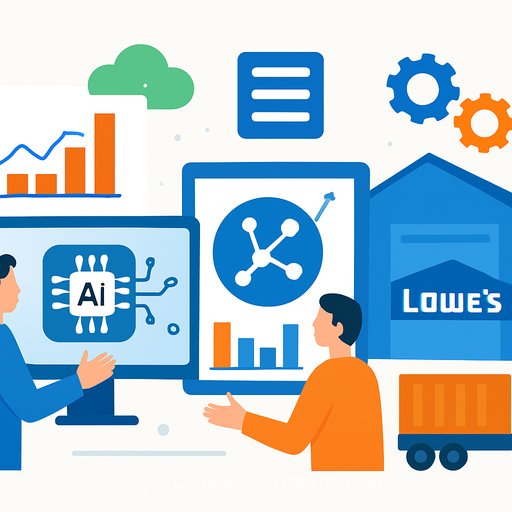NVIDIA and Palantir Team Up to Deliver an Integrated AI Stack for Operations in Government and Enterprise
NVIDIA ($NVDA) and Palantir Technologies ($PLTR) announced a partnership to deliver an integrated AI and analytics stack built for operational systems across enterprise and government. The collaboration pairs NVIDIA's accelerated computing and AI models with Palantir's Ontology and AI Platform (AIP) to drive data processing, automation, and decision intelligence at mission scale.
Palantir will embed NVIDIA CUDA-X libraries, Nemotron open models, and GPU acceleration into its Ontology-the backbone of AIP. The joint system is built to help teams create domain-specific AI agents and automation for logistics, healthcare, finance, and defense.
Why it matters for public agencies
This stack targets day-to-day execution, not just analysis. Think real-time resource allocation, case triage, intel fusion, supply routing, facility operations, and command support-where speed, accuracy, and auditability all matter.
Because Palantir's Ontology enforces structure and context, models can act on live operational data with policy controls. Combined with NVIDIA's compute and model suite, agencies get a path to AI agents that can reason over sensitive data while staying within governance boundaries.
What's in the stack
- NVIDIA: CUDA-X libraries, Nemotron open models, and GPU-accelerated computing, delivered through NVIDIA AI Enterprise and its supported tooling.
- Palantir: Ontology and AIP as the orchestration layer for data integration, model operations, guardrails, and agent workflows.
- Decision optimization: NVIDIA cuOpt for routing and scheduling to support logistics and supply-chain scenarios.
Future versions of Palantir AIP will integrate NVIDIA's Blackwell architecture to further speed up AI workflows and model deployment across this stack.
Early adopter: Lowe's
Lowe's is building a digital replica of its global supply chain to optimize routing, inventory placement, and cost. NVIDIA AI Enterprise and cuOpt will support real-time analytics and supply-chain management within this setup.
For public-sector teams, this offers a clear playbook for disaster response logistics, defense sustainment, and statewide distribution planning-anywhere you need visibility, simulation, and faster decisions over large operations.
Practical steps for government teams
- Start with one mission thread: Pick a high-value workflow (e.g., asset tasking, patient flow, case intake, routing) and define clear success metrics.
- Data readiness: Map sources into an ontology, resolve entity IDs, and set quality baselines. Bad data erodes model utility fast.
- Deployment model: Decide on on-prem, SCIF, or GovCloud with required authorizations (e.g., FedRAMP, IL levels). Confirm data residency and cross-domain needs.
- Pilot agents: Build small AI agents with strict guardrails, human review, and full audit logs. Expand only after measuring lift vs. baseline.
- Integrations: Connect to case systems, ERP, EHR, or C2 platforms via APIs. Plan for latency, failover, and role-based access control.
- Optimization: Use cuOpt for routing/scheduling where minutes and miles matter. Validate results against policy and on-the-ground constraints.
- Governance: Establish model cards, approval workflows, and red-teaming. Track prompts, outputs, and data lineage.
- Procurement & cost: Model TCO (compute, licensing, integration, training). Secure multi-year capacity for GPUs to avoid bottlenecks.
Security and compliance notes
- Confirm accreditation paths for AIP and NVIDIA components in your environment (FedRAMP, IL, CJIS, HIPAA as applicable).
- Enforce data segregation, least-privilege access, and comprehensive auditability.
- Use human-in-the-loop for decisions with legal, safety, or equity implications.
What to watch next
- Timelines for Blackwell-enabled AIP releases and availability in government regions.
- Reference architectures for defense, public health, emergency management, and transportation.
- Performance benchmarks for Nemotron models on mission data and edge deployments.
- Interoperability with existing mission systems and zero-trust architectures.
Key companies involved
- NVIDIA ($NVDA): GPU hardware, CUDA-X libraries, Nemotron models, and AI Enterprise forming the computational foundation. See NVIDIA AI Enterprise for platform details.
- Palantir Technologies ($PLTR): Integrating NVIDIA into its Ontology-based AIP for enterprise and government operations. Learn more about AIP here.
If your team is planning workforce training around AI deployment and oversight in public-sector settings, you can browse role-specific programs here: AI courses by job.
Editor's Note: This is a developing story. This article may be updated as more details become available.
Your membership also unlocks:






